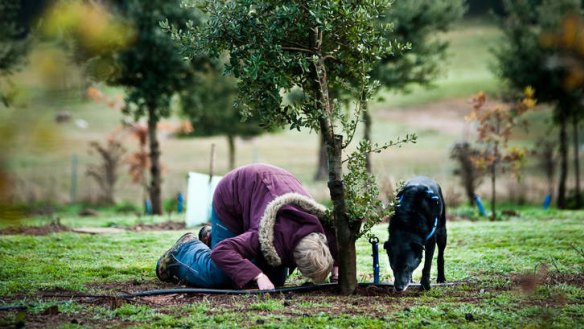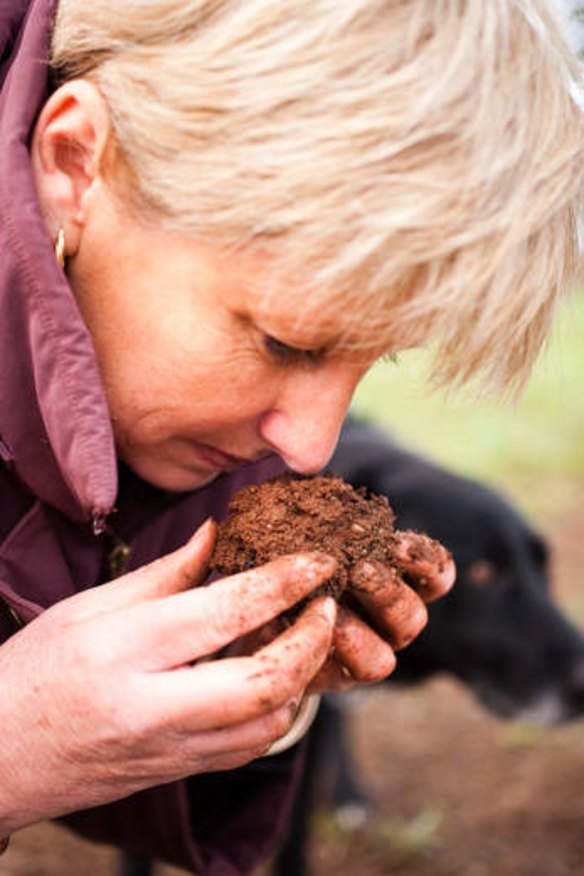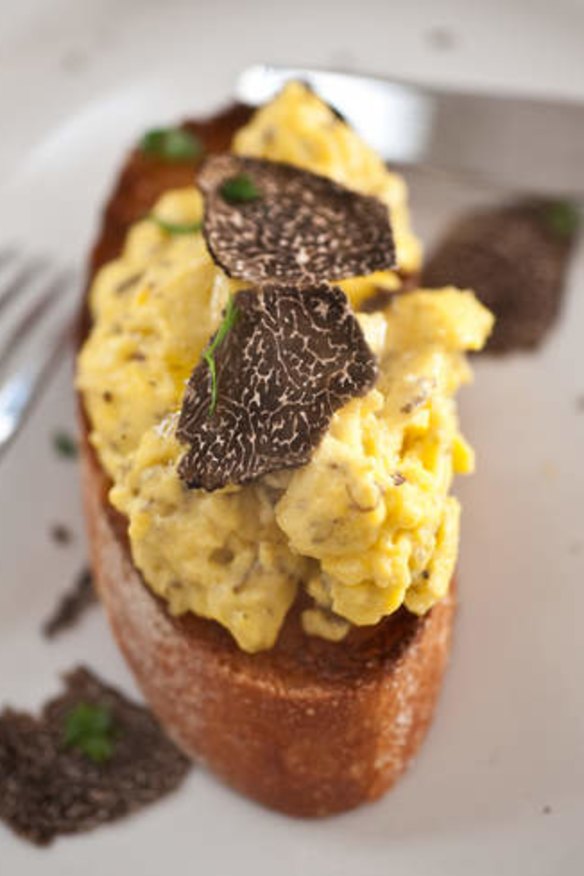Australian-grown truffles: Black gold bounty
It's hard to sniff out but, when fresh, you'll fall in love with this exquisite fungus.

Truffles are all about sex. Dirty, underground sex.
They are the reproductive body of a fungus that has a symbiotic relationship with trees such as oak and hazel. The trees give the thread-like fungus glucose and the fungus, in exchange, passes on nutrients it has taken from the soil where the trees' roots can't reach.

The truffle grows underground on the roots near the trunk. It is full of spores to make more truffles. The trouble is, being underground, it needs a way of getting out in the wild to sow its wild oats, as it were. These knobbly fungi have evolved in the northern hemisphere to make the most of highly-sexed, warm-blooded animals who are turned on by a truffle's scent. When ripe, it exudes a plethora of aromas to entice mammals such as squirrels and deer to dig it up out of the ground, eat it and pass on its spores.
One of those aromas is androstenone, a steroid found in the saliva of male pigs (and underarms of men) that sends sows into love mode. I have never been turned on by a truffle. Sorry, there was one. A white truffle from Italy the size of a prized gold nugget was presented on a velvet pillow for a vanity auction in Madrid. I was allowed to smell it. It was glorious. Surrounded by an invisible envelope of aromas, it was like an olfactory tractor beam drawing me inevitably closer to the creamy truffle. There was a heady mix of aromas: brief punches of tropical fruit, the best cooked egg, camembert, something chocolatey and, there in the background, a smell akin to some young lover's warm bed.
Since then, I haven't experienced the same hit. I have paid the $20 supplement in restaurants for a thick shaving of truffles flown in from Western Australia, that could just as easily have been black-painted stale bread. I was sold a $60 Tasmanian truffle that emitted as much aroma as a dead ember. My experience with Australian truffles led me to believe that either Australian truffles were rubbish or I simply couldn't smell them. Some people simply can't smell androstenone. Perhaps I was one of them.

There are truffles that have almost no aroma. A winemaker mate with a vineyard in Gippsland in Eastern Victoria recently dropped one in. A native truffle.
''I don't know what all the fuss about truffles is about,'' he said. ''The blackfellas have been eating them for 40,000 years.''
With that he pulled out a deep brown truffle the size of his meaty fist. Previously I had seen one in an Aboriginal cultures museum in Bairnsdale, next to a grinding stone. The indigenous guide told me how they were referred to as ''blackfella's bread'' and were ground into a paste and cooked like damper. The one my mate had unearthed was as hard as a tough pumpkin to cut open and looked like dense German rye bread inside. It was tough and tasteless. Not unlike the truffles I had been used to, I commented. ''You should get out more,'' came the reply from my mate. ''There is nothing better than a fresh truffle.''
Which is why I found myself on all fours under an oak tree, my face buried into the rich red earth at Creswick near Ballarat. Ella the truffle dog at Black Cat Cottage & Truffles had pawed a spot under a small evergreen oak, indicating there was a ripe truffle underneath. Truffle farmer Lynette Haas sniffed the earth to confirm it was ripe. The earth emitted a rich, mushroomy aroma. At that moment I began to change my mind about Australian-grown truffles. Using a hand-made Italian truffle blade, Haas cut away the earth with archaeologist-like care to reveal a knobbly, golf ball-sized truffle. She says the truffles form on the roots at the beginning of summer, then ripen over autumn but require several good frosts for them to mature completely.
In her kitchen are several truffles harvested the previous day. One large specimen is top grade and has a small nick in it to show off the dark chocolate, almost-black flesh inside, veined with streaks of white. It will sell for about $2.50 a gram. It smells of warm malted milk. Another has the pleasant aroma of white-mould cheese. A third has the aroma of young corn and its moist silk. The fourth has an unmistakable raunchy scent.
Haas' husband Andres takes a few eggs that have been resting with a cut truffle and gently scrambles them in a pot with a little butter. Into them he grates the merest of fresh truffle with a Microplane. The soft eggs are spooned over some toasted baguette and finished with several scant slices of more truffle. Andres says that many aroma compounds in truffle are destroyed if it's heated above 80 degrees. He also adds that truffles are best fresh. He presents the dish, humble in its simplicity but regal in the way it delivers the smoothness of the eggs and those heady, mushroomy aromas rising on the steam, with hints of floral and the smell of sex. Fresh truffles are definitely the best.
KNOW YOUR TRUFFLE
Store truffles on a bed of risotto rice in a glass jar in the fridge. Use the rice for risotto. Alternatively, keep the truffle in a sealed container with eggs. The aromas will permeate the porous shell and flavour the eggs.
A decent sized 20-gram black truffle will cost around $50 but it goes a long way. Truffle farmer Andres Haas recommends a long, slow truffle weekend where one uses the truffle several ways. Take a 100-gram wedge of ripe but chilled, good, white-mould cheese cut in half to expose the centre and shave three grams over the middle. Close it back up, wrap it in baking paper, and return it to the fridge to let the flavours develop for a few days. Serve at room temperature. Grate two to three grams into four eggs before soft scrambling, then slice another three to four grams of truffle. Use the remaining truffle to finish a pasta dish or something else. Again, use some in the cooking process, but shave most of it over at the end and allow it to warm through the meal.
Black truffle (Tuber melanosporum) Most famously harvested in the forests of Perigord in France, it is harvested throughout Europe in the northern winter. Now grown commercially in Victoria, New South Wales, ACT, Tasmania and Western Australia.
Summer truffle (Tuber aestivum) A European truffle that is ripe at the end of summer. Grown in small quantities in Australia. Not as highly prized as the black truffle.
White truffle (Tuber magnatum) Growing alongside beech, hazel, oak and poplar, it is most famously harvested in Alba in Italy but grown in certain other parts of Europe. Imported into Australia in our spring.
Blackfella's bread (Laccocephalum mylittae) Native truffle growing symbiotically with eucalyptus trees. Naturally occurring and not harvested commercially.
Melbourne Truffle Festival
This inaugural festival is a two-day celebration of the truffle, where people can enjoy truffles paired with cheese, charcuterie, beer and burgers, with tasting plates and banquets prepared by Philippe Mouchel, Guy Grossi and Manu Feildel. July 12-13. Caulfield Racecourse. Adults, $25; children, $10. trufflemelbourne.com
Black Cat Truffle Classes
Truffle Shuffle Sunday, July 13. Morning tea, truffle hunt and three-course truffle-themed lunch; $160.
Truffles Made Easy Sunday July 20 and August 3. Hunt for truffles then learn to cook with them with chef Peter Ford; $160. blackcattruffles.com.au
Restaurant reviews, news and the hottest openings served to your inbox.
Sign up- More:
- Restaurant news
